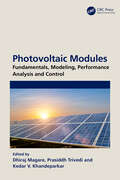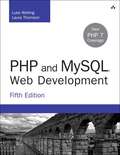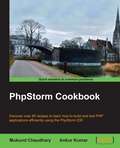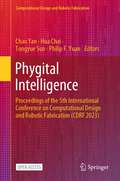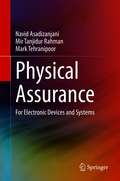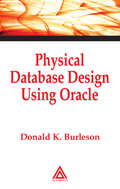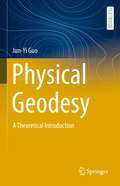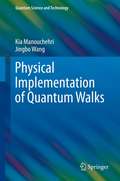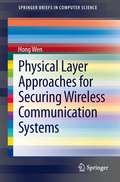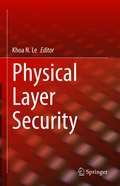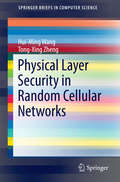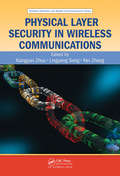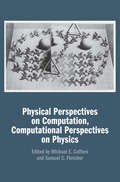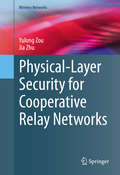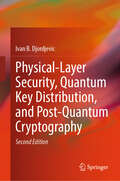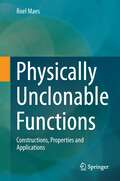- Table View
- List View
Photoshop for Artists: A Complete Guide for Fine Artists, Photographers, and Printmakers
by Sylvie CoveyENRICH, ENHANCE, AND TRANSFORM YOUR ART WITH THE MAGIC OF PHOTOSHOP® For artists, Adobe® Photoshopâ offers an exciting entry into a new world of limitless color, textures, and effects that can be applied with just the touch of a keyboard or click of a mouse. Intended for serious artists -- painters, photographers, and printmakers -- Photoshop for Artists provides a comprehensive series of detailed tutorials, cataloging the various tools, techniques, and methods for producing an infinite variety of creative imagery with Photoshop. With thirty tutorials divided into sections for fine artists, photographers, and printmakers, this book contains easy-to-follow step-by-step examples that include all the information serious professional artists need to master the digital art techniques of Photoshop. Each tutorial features screenshots and detailed directions, so artists can see exactly how the specific effects are achieved and applied to artwork. Featuring stunning and dramatic imagery produced by the author and other accomplished artists, Photoshop for Artists is essential reading for artists looking to take their work to the next digital level.
Photovoltaic Modules: Fundamentals, Modeling, Performance Analysis and Control
by Dhiraj Magare, Prasiddh Trivedi and Kedar V. KhandeparkarThe book provides a comprehensive review of developments in all aspects of solar photovoltaic technology in a single volume. It discusses maximum power point tracking (MPPT) control for achieving maximum possible power, robust control to maintain stable operation under varying internal as well as the ambient environment, inverter control for constant frequency operation, and automating the maintenance of photovoltaic solar plants. This book: Presents modeling methods based on mathematical and physical principles for solar photovoltaic cells, power quality analysis of rooftop grid-connected PV, and PV generation analyzed by bidirectional long short-term memory networks (BiLSTM) to evaluate the performance reliability of the bifacial module and the control system of the synchronous reference CCVSI for active power injection Provides an overview of SPECS control, various control loops, control algorithms, controllers, and their impact on the prosumer and the smart grid and discusses instantaneous power theory (pq theory) Covers control techniques of power electronic converters, optimization techniques, and management of the grid-connected solar PV arrays, qualification testing of bifacial modules as per IEC- 61215: 2021 and IEC 61730, including analytical approach elaborated for the performance of a building-integrated solar PV/T system Discusses and comprehensively reviews degradation mechanisms, characterization techniques, and occurrence frequencies based on field testing, long-term analyses of PV installations, harmonic compensation, and the enhancement of Power Quality for the entire system, a novel approach of developing an effective and systematic brownout procedure and a novel game theory auctioning framework for trading energy in smart grids and explains Gbest-guided Artificial Bee Colony (GABC) optimization Includes real-life case studies It will serve as an ideal reference text for senior undergraduate, graduate students, and academic researchers in fields including electrical engineering, electronics and communications engineering, environmental engineering, and renewable energy.
Photovoltaic Sources
by Gianpaolo Vitale Maria Carmela Di PiazzaModeling of photovoltaic sources and their emulation by means of power electronic converters are challenging issues. The former is tied to the knowledge of the electrical behavior of the PV generator; the latter consists in its realization by a suitable power amplifier. This extensive introduction to the modeling of PV generators and their emulation by means of power electronic converters will aid in understanding and improving design and set up of new PV plants. The main benefit of reading Photovoltaic Sources is the ability to face the emulation of photovoltaic generators obtained by the design of a suitable equipment in which voltage and current are the same as in a real source. This is achieved according to the following steps: the source electrical behavior modeling, the power converter design, including its control, for the laboratory emulator. This approach allows the reader to cope with the creation of an indoor virtual photovoltaic plant, in which the environmental conditions can be imposed by the user, for testing real operation including maximum power point tracking, partial shading, control for the grid or load interfacing, etc. Photovoltaic Sources is intended to meet the demands of postgraduate level students, and should prove useful to professional engineers and researchers dealing with the problems associated with modeling and emulation of photovoltaic sources.
Php And Mysql Web Development (Developer's Library)
by Luke Welling Laura ThomsonPHP and MySQL Web Development teaches the reader to develop dynamic, secure, commercial Web sites. Using the same accessible, popular teaching style of the first edition, this best-selling book has been updated to reflect the rapidly changing landscape of MySQL and PHP. The book teaches the reader to integrate and implement these technologies by following real-world examples and working sample projects, and also covers related technologies needed to build a commercial Web site, such as SSL, shopping carts, and payment systems. The second edition includes new coverage of how to work with XML in developing a PHP and MySQL site, and how to draw on the valuable resources of the PEAR repository of code and extensions.
PhpStorm Cookbook
by Mukund Chaudhary Ankur KumarIf you are a competent PHP developer who knows the basics of PHPStorm and intends to gain better knowledge of PHPStorm by learning and implementing pro-level practices, techniques, and solutions, then this book is for you. It is assumed that you already have a working installation of the software setup.
Phygital Intelligence: Proceedings of the 5th International Conference on Computational Design and Robotic Fabrication (CDRF 2023) (Computational Design and Robotic Fabrication)
by Philip F. Yuan Chao Yan Hua Chai Tongyue SunThis open access book is a compilation of selected papers from 2023 DigitalFUTURES — The 5nd International Conference on Computational Design and Robotic Fabrication (CDRF 2023). The work focuses on novel techniques for computational design and robotic fabrication. The contents make valuable contributions to academic researchers, designers, and engineers in the industry. As well, readers will encounter new ideas about understanding intelligence in architecture.
Phylogenomics: A Primer
by Rob DeSalle Jeffrey Rosenfeld Michael TesslerPhylogenomics: A Primer, Second Edition is for advanced undergraduate and graduate biology students studying molecular biology, comparative biology, evolution, genomics, and biodiversity. This book explains the essential concepts underlying the storage and manipulation of genomics level data, construction of phylogenetic trees, population genetics, natural selection, the tree of life, DNA barcoding, and metagenomics. The inclusion of problem-solving exercises in each chapter provides students with a solid grasp of the important molecular and evolutionary questions facing modern biologists as well as the tools needed to answer them.
Physical Assurance: For Electronic Devices and Systems
by Mark Tehranipoor Navid Asadizanjani Mir Tanjidur RahmanThis book provides readers with a comprehensive introduction to physical inspection-based approaches for electronics security. The authors explain the principles of physical inspection techniques including invasive, non-invasive and semi-invasive approaches and how they can be used for hardware assurance, from IC to PCB level. Coverage includes a wide variety of topics, from failure analysis and imaging, to testing, machine learning and automation, reverse engineering and attacks, and countermeasures.
Physical Database Design Using Oracle (Foundations Of Database Design Ser.)
by Donald K. BurlesonThe evolution of Oracle has led to a revolution in design practices. For Oracle 10g, database physical structures have become more complex than ever before and database designers face multiple ways to implement their logical models. IS students studying database design and administration need to be able to implement management systems in a way that
Physical Geodesy: A Theoretical Introduction (Springer Textbooks in Earth Sciences, Geography and Environment)
by Jun-Yi GuoThis textbook introduces physical geodesy. It treats the boundary-value theories of the discipline comprehensively, and provides insights to the theory of gravity reduction based on a spherical Earth model. This book is for students who wish to thoroughly understand the material and to expand their knowledge and skills in mathematics for more advanced study and research in this discipline. The details of mathematical derivations included are a useful asset for instructors and researchers.
Physical Implementation of Quantum Walks
by Kia Manouchehri Jingbo WangGiven the extensive application of random walks in virtually every science related discipline, we may be at the threshold of yet another problem solving paradigm with the advent of quantum walks. Over the past decade, quantum walks have been explored for their non-intuitive dynamics, which may hold the key to radically new quantum algorithms. This growing interest has been paralleled by a flurry of research into how one can implement quantum walks in laboratories. This book presents numerous proposals as well as actual experiments for such a physical realization, underpinned by a wide range of quantum, classical and hybrid technologies.
Physical Layer Approaches for Securing Wireless Communication Systems
by Hong WenThis book surveys the outstanding work of physical-layer (PHY) security, including the recent achievements of confidentiality and authentication for wireless communication systems by channel identification. A practical approach to building unconditional confidentiality for Wireless Communication security by feedback and error correcting code is introduced and a framework of PHY security based on space time block code (STBC) MIMO system is demonstrated. Also discussed is a scheme which combines cryptographic techniques implemented in the higher layer with the physical layer security approach using redundant antennas of MIMO systems to provide stronger security for wireless networks. The channel responses between communication peers have been explored as a form of fingerprint with spatial and temporal uniqueness. Finally, the book develops a new lightweight method of channel identification for Sybil attack and node clone detection in wireless sensor networks (WSNs).
Physical Layer Multi-Core Prototyping
by Slaheddine Aridhi Jean-François Nezan Maxime Pelcat Jonathan PiatBase stations developed according to the 3GPP Long Term Evolution (LTE) standard require unprecedented processing power. 3GPP LTE enables data rates beyond hundreds of Mbits/s by using advanced technologies, necessitating a highly complex LTE physical layer. The operating power of base stations is a significant cost for operators, and is currently optimized using state-of-the-art hardware solutions, such as heterogeneous distributed systems. The traditional system design method of porting algorithms to heterogeneous distributed systems based on test-and-refine methods is a manual, thus time-expensive, task. Physical Layer Multi-Core Prototyping: A Dataflow-Based Approach provides a clear introduction to the 3GPP LTE physical layer and to dataflow-based prototyping and programming. The difficulties in the process of 3GPP LTE physical layer porting are outlined, with particular focus on automatic partitioning and scheduling, load balancing and computation latency reduction, specifically in systems based on heterogeneous multi-core Digital Signal Processors. Multi-core prototyping methods based on algorithm dataflow modeling and architecture system-level modeling are assessed with the goal of automating and optimizing algorithm porting. With its analysis of physical layer processing and proposals of parallel programming methods, which include automatic partitioning and scheduling, Physical Layer Multi-Core Prototyping: A Dataflow-Based Approach is a key resource for researchers and students. This study of LTE algorithms which require dynamic or static assignment and dynamic or static scheduling, allows readers to reassess and expand their knowledge of this vital component of LTE base station design.
Physical Layer Security
by Khoa N. LeThis book studies the vulnerability of wireless communications under line-of-sight (LoS) and non-LoS correlated fading environments. The authors theoretically and practically provide physical layer security analyses for several technologies and networks such as Fifth-Generation (5G) networks, Internet of Things (IoT) applications, and Non-orthogonal multiple access (NOMA). The authors have provided these under various practical scenarios, and developed theoretical aspects to validate their proposed applications. Presents physical layer security (PLS) under correlated fading environments, 5G wireless networks, and NOMA networks;Provides end-to-end analyses, combination of channel correlation and outdated CSI and their effects on PL;Includes contributions of PLS research written by global experts in academia and industry.
Physical Layer Security in Power Line Communications: Fundamentals, Models and Applications (Advances in Information Security #108)
by Roberto Di Pietro Javier Hernandez Fernandez Aymen OmriThis book emerges as a seminal work, addressing the critical need for robust security for power line communications (PLC), during an era where digital interconnectivity is paramount yet vulnerable. This comprehensive volume offers a deep dive into the realm of PLC, a technology increasingly central to our interconnected power grid infrastructure and explores its potential as a cornerstone for various applications. This book opens with a clear and informative introduction to PLC, shedding light on its present status and importance. The authors then delve into the heart of the matter: the application of physical layer security (PLS) in PLC networks. PLS, an emerging field in its own right, is presented as a vital complement or alternative to traditional communications security methods, especially relevant for securing networks of low-complexity devices that are pivotal in PLC applications. This exhaustive treatment of PLS in PLC is unprecedented, both in its scope and depth. This book not only clarifies the fundamental principles of PLS in PLC, but also provides actionable insights for mitigating risks and enhancing resilience. Targeted towards engineers, researchers, graduate students and practitioners grappling with the multifaceted aspects of cybersecurity in energy infrastructure, this book stands out for its clarity, rigor, and the practical applicability of its content. The authors share the results of their extensive research journey and practice, presenting compelling use cases that underscore the practicality of their findings, as well as insights to be prepared for the next challenges in the security of the grid infrastructure.
Physical Layer Security in Random Cellular Networks
by Hui-Ming Wang Tong-Xing ZhengThis book investigates key security issues in connection with the physical layer for random wireless cellular networks. It first introduces readers to the fundamentals of information theoretic security in the physical layer. By examining recently introduced security techniques for wireless point-to-point communications, the book proposes new solutions to physical layer security based on stochastic geometric frameworks for random cellular networks. It subsequently elaborates on physical-layer security in multi-tier heterogeneous networks. With the new modeled settings, the authors also verify the security performance with the impact of the full-duplex transceivers. The specific model design presented here offers a valuable point of reference for readers in related areas. In addition, the book highlights promising topics and proposes potential future research directions.
Physical Layer Security in Wireless Communications (Wireless Networks and Mobile Communications #20)
by Lingyang Song Yan Zhang Xiangyun ZhouPhysical layer security has recently become an emerging technique to complement and significantly improve the communication security of wireless networks. Compared to cryptographic approaches, physical layer security is a fundamentally different paradigm where secrecy is achieved by exploiting the physical layer properties of the communication syst
Physical Perspectives on Computation, Computational Perspectives on Physics
by Michael E. Cuffaro Samuel C. FletcherAlthough computation and the science of physical systems would appear to be unrelated, there are a number of ways in which computational and physical concepts can be brought together in ways that illuminate both. <P><P>This volume examines fundamental questions which connect scholars from both disciplines: is the universe a computer? Can a universal computing machine simulate every physical process? What is the source of the computational power of quantum computers? Are computational approaches to solving physical problems and paradoxes always fruitful? Contributors from multiple perspectives reflecting the diversity of thought regarding these interconnections address many of the most important developments and debates within this exciting area of research. Both a reference to the state of the art and a valuable and accessible entry to interdisciplinary work, the volume will interest researchers and students working in physics, computer science, and philosophy of science and mathematics.<P> Fills the gap in the book-length treatments of the interrelations between computation and physics, especially within philosophy.<P> Provides a reference point for the state of the art in important topics and research questions in this area.<P> Brings together scholars from a wide range of perspectives and disciplines.
Physical Security and Safety: A Field Guide for the Practitioner (Occupational Safety & Health Guide Series #17)
by Truett A. Ricks Bobby E. Ricks Jeff DingleHow-To Guide Written By Practicing ProfessionalsPhysical Security and Safety: A Field Guide for the Practitioner introduces the basic principles of safety in the workplace, and effectively addresses the needs of the responsible security practitioner. This book provides essential knowledge on the procedures and processes needed for loss reduction, p
Physical and Data-Link Security Techniques for Future Communication Systems
by Marco Baldi Stefano TomasinThis book focuses on techniques that can be applied at the physical and data-link layers of communication systems in order to secure transmissions against eavesdroppers. Topics ranging from information theory-based security to coding for security and cryptography are discussed, with presentation of cutting-edge research and innovative results from leading researchers. The characteristic feature of all the contributions is their relevance for practical embodiments: detailed consideration is given to applications of security principles to a variety of widely used communication techniques such as multiantenna systems, ultra-wide band communication systems, power line communications, and quantum key distribution techniques. A further distinctive aspect is the attention paid to both unconditional and computational security techniques, providing a bridge between two usually distinct worlds. The book comprises extended versions of contributions delivered at the Workshop on Communication Security, held in Ancona, Italy, in September 2014 within the framework of the research project "Enhancing Communication Security by Cross-layer Physical and Data-link Techniques", funded by the Italian Ministry of Education, Universities, and Research.
Physical-Layer Security and Quantum Key Distribution
by Ivan B. DjordjevicThis textbook integrates the most advanced topics of physical-layer security, cryptography, covert/stealth communications, quantum key distribution (QKD), and cyber security to tackle complex security issues. After introducing the reader to various concepts and practices, the author addresses how these can work together to target problems, rather than treating them as separate disciplines. This book offers students an in-depth exposition on: cryptography, information-theoretic approach to cryptography, physical-layer security, covert/stealth/low-probability of detection communications, quantum information theory, QKD, and cyber security; to mention few. The goal is to provide a unified description of the most advanced topics related to: (i) modern cryptography, (ii) physical-layer security, (iii) QKD, (iv) covert communications, and (v) cyber security. Each chapter is followed by a set of problems. Also, for readers to better understand the book, an appendix covers all needed background. Homework problems and lecture notes are available online. The book does not require any prior knowledge or prerequisite material.
Physical-Layer Security for Cooperative Relay Networks
by Yulong Zou Jia ZhuThis book presents physical-layer security as a promising paradigm for achieving the information-theoretic secrecy required for wireless networks. It explains how wireless networks are extremely vulnerable to eavesdropping attacks and discusses a range of security techniques including information-theoretic security, artificial noise aided security, security-oriented beamforming, and diversity assisted security approaches. It also provides an overview of the cooperative relaying methods for wireless networks such as orthogonal relaying, non-orthogonal relaying, and relay selection. Chapters explore the relay-selection designs for improving wireless secrecy against eavesdropping in time-varying fading environments and a joint relay and jammer selection for wireless physical-layer security, where a relay is used to assist the transmission from the source to destination and a friendly jammer is employed to transmit an artificial noise for confusing the eavesdropper. Additionally, the security-reliability tradeoff (SRT) is mathematically characterized for wireless communications and two main relay-selection schemes, the single-relay and multi-relay selection, are devised for the wireless SRT improvement. In the single-relay selection, only the single best relay is chosen for assisting the wireless transmission, while the multi-relay selection invokes multiple relays for simultaneously forwarding the source transmission to the destination. Physical-Layer Security for Cooperative Relay Networks is designed for researchers and professionals working with networking or wireless security. Advanced-level students interested in networks, wireless, or privacy will also find this book a useful resource.
Physical-Layer Security, Quantum Key Distribution, and Post-Quantum Cryptography
by Ivan B. DjordjevicThis book introduces the reader to the most advanced topics of physical-layer security (PLS), cryptography, covert/stealth communications, and quantum key distribution (QKD), also known as the quantum cryptography, and post-quantum cryptography (PQC). So far, these topics have been considered as separate disciplines, even though they are targeting the same security problems we are facing today. The book integrates modern cryptography, physical-layer security, QKD, covert communication, PQC, and cyber security technologies. The book is intended for a very diverse group of readers in communications engineering, optical engineering, wireless communications, free-space optical communications, optical wireless communications, mathematics, physics, communication theory, information theory, photonics, as well as computer science.
Physically Based Rendering, fourth edition: From Theory to Implementation
by Matt Pharr Greg Humphreys Wenzel JakobA comprehensive update of the leading-edge computer graphics textbook that sets the standard for physically-based rendering in the industry and the field, with new material on GPU ray tracing.Photorealistic computer graphics are ubiquitous in today&’s world, widely used in movies and video games as well as product design and architecture. Physically-based approaches to rendering, where an accurate modeling of the physics of light scattering is at the heart of image synthesis, offer both visual realism and predictability. Now in a comprehensively updated new edition, this best-selling computer graphics textbook sets the standard for physically-based rendering in the industry and the field. Physically Based Rendering describes both the mathematical theory behind a modern photorealistic rendering system as well as its practical implementation. A method known as literate programming combines human-readable documentation and source code into a single reference that is specifically designed to aid comprehension. The book&’s leading-edge algorithms, software, and ideas—including new material on GPU ray tracing—equip the reader to design and employ a full-featured rendering system capable of creating stunning imagery. This essential text represents the future of real-time graphics. Detailed and rigorous but accessible approach guides readers all the way from theory to practical software implementationFourth edition features new chapter on GPU ray tracing essential for game developersThe premier reference for professionals learning about and working in the fieldWon its authors a 2014 Academy Award for Scientific and Technical Achievement Includes a companion site complete with source code
Physically Unclonable Functions
by Roel MaesPhysically unclonable functions (PUFs) are innovative physical security primitives that produce unclonable and inherent instance-specific measurements of physical objects; in many ways they are the inanimate equivalent of biometrics for human beings. Since they are able to securely generate and store secrets, they allow us to bootstrap the physical implementation of an information security system. In this book the author discusses PUFs in all their facets: the multitude of their physical constructions, the algorithmic and physical properties which describe them, and the techniques required to deploy them in security applications. The author first presents an extensive overview and classification of PUF constructions, with a focus on so-called intrinsic PUFs. He identifies subclasses, implementation properties, and design techniques used to amplify submicroscopic physical distinctions into observable digital response vectors. He lists the useful qualities attributed to PUFs and captures them in descriptive definitions, identifying the truly PUF-defining properties in the process, and he also presents the details of a formal framework for deploying PUFs and similar physical primitives in cryptographic reductions. The author then describes a silicon test platform carrying different intrinsic PUF structures which was used to objectively compare their reliability, uniqueness, and unpredictability based on experimental data. In the final chapters, the author explains techniques for PUF-based entity identification, entity authentication, and secure key generation. He proposes practical schemes that implement these techniques, and derives and calculates measures for assessing different PUF constructions in these applications based on the quality of their response statistics. Finally, he presents a fully functional prototype implementation of a PUF-based cryptographic key generator, demonstrating the full benefit of using PUFs and the efficiency of the processing techniques described. This is a suitable introduction and reference for security researchers and engineers, and graduate students in information security and cryptography.

